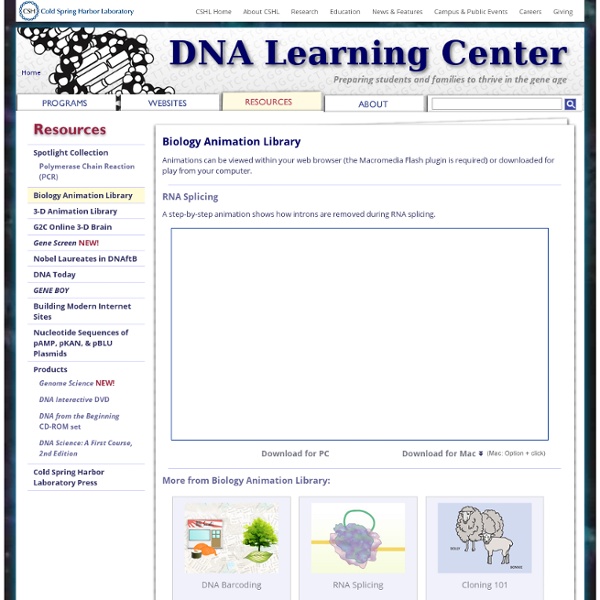



http://www.dnalc.org/resources/animations/
Activation Energy and Enzymes TITLE: Activation Energy and EnzymesSOURCE: Freeman, S, Biological Science, Second Edition, Pearson Prentice Hall, Inc.© 2006 Pearson Prentice Hall, Inc.KEYWORDS: Activation energy, enzymes, exergonic reactions, ATP, activation energy, catalysts, lock-and-key model, induced-fit model Methods and protocols in molecular biology - GFP Applications Page designed by Wallace Marshall, Yale University. {*style:<b>Added: 28-Nov-1999 Hits: 982 Rating: 7.33 Votes: 3 [ Rate It ] </b>*} Biology Animations Carnegie Mellon's Office of Technology for Education and Department of Biological Sciences create multimedia materials for teaching and learning Biology. After an analysis of a number of Biology courses was performed to identify when and how shared concepts where taught, a team of biologists, media programmers, and learning experts came together to create animations designed to improve understanding of some of the main concepts taught in Modern Biology and Biochemistry. Phosopholipid Membranes Tutorial page describing the construction and properties of Biological Membranes. Biological Membranes Biological membranes are dynamic structures composed of a diverse set of phospholipid molecules and proteins.
All Non-Africans Part Neanderthal, Genetics Confirm If your heritage is non-African, you are part Neanderthal, according to a new study in the July issue of Molecular Biology and Evolution. Discovery News has been reporting on human/Neanderthal interbreeding for some time now, so this latest research confirms earlier findings. Damian Labuda of the University of Montreal's Department of Pediatrics and the CHU Sainte-Justine Research Center conducted the study with his colleagues. They determined some of the human X chromosome originates from Neanderthals, but only in people of non-African heritage.
How Water Shapes DNA Water molecules surround the genetic material DNA in a very specific way. Scientists at the Helmholtz-Zentrum Dresden-Rossendorf (HZDR) have discovered that, on the one hand, the texture of this hydration shell depends on the water content and, on the other hand, actually influences the structure of the genetic substance itself. These findings are not only important in understanding the biological function of DNA; they could also be used for the construction of new DNA-based materials. The DNA's double helix never occurs in isolation; instead, its entire surface is always covered by water molecules which attach themselves with the help of hydrogen bonds. But the DNA does not bind all molecules the same way.
Nuclear reactor and power plant simulation Introduction This is not a lesson like the others in Radioactivity and Atomic Physics Explained but it fits in well with the lesson on nuclear power. It is a very sophisticated simulation of a pressurised water reactor (PWR), which is the most common type of nuclear power reactor in the US but not in Europe, though the principles are very similar. DAVID: Gene Functional Classification What does this tool do? Quickly translate given gene IDs to corresponding gene names in a batch way Provide links for each genes to DAVID Gene Report for in-depth information Search functionally related genes within user's input gene list or genome Key Concepts of "Search Related Genes" Any given gene is associating with a set of annotation terms. If genes share similar set of those terms (annotation profile), they are most likely involved in similar biological mechanisms. The algorithm adopts kappa statistics to quantitatively measure the degree of the agreement how genes share the ~75,000 annotation terms collected by DAVID knowledgebase.
The PCR Method - a DNA Copying Machine Lists of Nobel Prizes and Laureates The PCR Method - a DNA Copying Machine Play the Eye of the Donkey Game About the game Scientists observe single gene activity in living cells in detail for first time Researchers at Albert Einstein College of Medicine of Yeshiva University have for the first time observed the activity of a single gene in living cells. In an unprecedented study, published in the April 22 online edition of Science, Einstein scientists were able to follow, in real time, the process of gene transcription, which occurs when a gene converts its DNA information into molecules of messenger RNA (mRNA) that go on to make the protein coded by the gene. Robert Singer, Ph.D., co-director of the Gruss Lipper Biophotonics Center at Einstein and professor and co-chair of anatomy and structural biology, is senior author of the paper. The study's lead author is Daniel Larson, Ph.D., previously a member of Dr. Singer's lab and now an investigator at the National Cancer Institute and head of the institute's Systems Biology of Gene Expression Section.
vamnies on Vodpod - Videos about Or join with email Or Join with Email By joining, you agree to our Terms of Use and Privacy Policy. Or Sign in with email Forgot your password? Forgot your password PLoS Biology : Publishing science, accelerating research A Peer-Reviewed, Open Access Journal Current Issue PLOS Biology is a peer-reviewed, open-access journal featuring research articles of exceptional significance in all areas of biological science, from molecules to ecosystems. New Self-Cloning Lizard Found in Vietnam Restaurant {*style:<b>You could call it the surprise du jour: A popular food on Vietnamese menus has turned out to be a lizard previously unknown to science, scientists say. </b>*} What's more, the newfound is no run-of-the-mill reptile —the all-female species reproduces via cloning, without the need for male lizards. Single-gender lizards aren't that much of an oddity: About one percent of lizards can reproduce by parthenogenesis, meaning the females spontaneously ovulate and clone themselves to produce offspring with the same genetic blueprint. (Related: "Virgin Birth Expected at Christmas—By Komodo Dragon." )